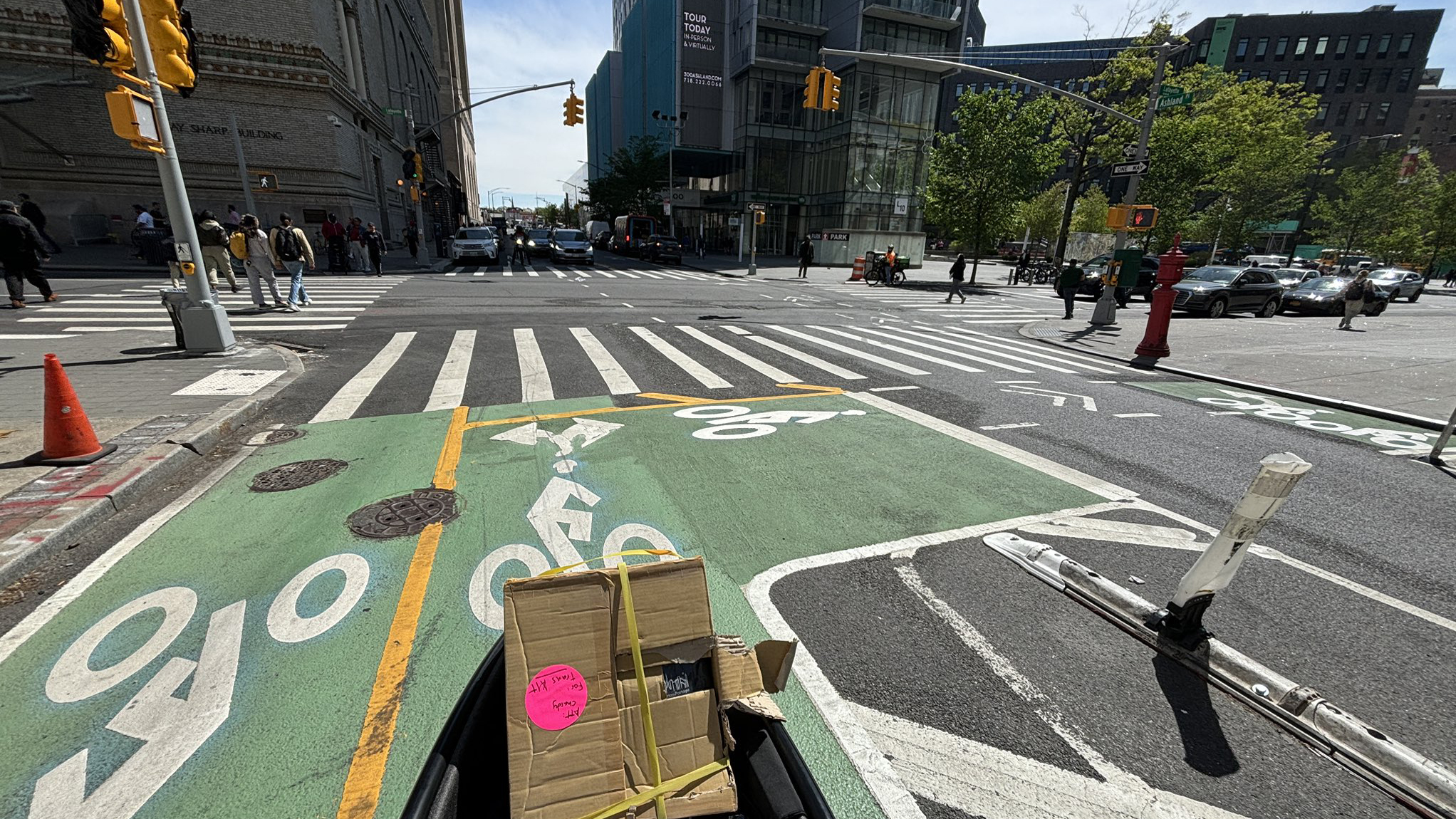The deadline to apply to NYC DOT for a neighborhood slow zone is tomorrow, and groups from many different corners of New York are making their case for bringing a 20 mph speed limit and traffic calming measures to their neighborhoods.
"We are hearing from people applying for zones all over the city," said Lindsey Ganson, Transportation Alternatives' safety campaign director.
One exciting application comes from the Bronx Helpers, the team of middle and high-schoolers who have been fighting for safety improvements near their school at 172nd Street and Townsend for two years. The group started by asking just for a stop sign, collecting over 1,000 signatures from their neighbors. When DOT rejected their request without explanation, the group teamed up with TA, measured speeding with radar guns and counted pedestrian volumes, and changed their request to emphasize traffic calming.
Now the Bronx Helpers are working through DOT's new slow zone program to try and get neighborhood-wide safety fixes. "We thought it was a great opportunity to expand and make the whole area more pedestrian-friendly," said Bronx Helpers staff member Molly Berman.
The group applied for the entirety of the Mt. Eden section of the Bronx, located between 174th Street, 170th Street, the Grand Concourse and Jerome Avenue. With four schools, two daycares and a senior center in the area, it's a neighborhood with lots of pedestrians who need safer streets.
Signing on in support of the slow speed zone are a slew of neighborhood groups and some prominent political figures. Three school principals wrote letters of support, as did a tenants' rights organization, Bronx Community Board 4, and the Deputy Borough President, Aurelia Greene.
Also writing in support of the proposal is Public Advocate Bill de Blasio."I believe it is clear that their proposed Slow Zone -- from 10th to 174th and Grand Concourse to Jerome Avenue -- is based on strong stakeholder engagement and presents compelling evidence of the need for greater pedestrian safety," de Blasio wrote in a letter to DOT.
In Rego Park, Queens, Council Member Karen Koslowitz is championing the neighborhood's slow zone application. The Rego Park Green Alliance submitted the bid for the triangle between Woodhaven Boulevard, 63rd Drive and the Long Island Railroad tracks. In addition to writing DOT, Koslowitz promised to bring the department on a tour of the neighborhood, said Yvonne Shortt, who has helped lead the push for the slow zone.
"I applied because on December 22, I saw a girl almost killed by two cars speeding and traveling in opposite directions on the narrow streets of Alderton," Shortt told Streetsblog. "That was the last straw." Residents and local businesses alike have signed her petition showing neighborhood support for slower speeds. Shortt argued that her neighborhood's residential character makes it a good fit for the 20 mph zone. "Cars don't realize how narrow the streets are. They're already going too fast."
The Fort Greene Association has perhaps the most ambitious proposal, asking for not one but two separate slow zones. "It didn't seem fair to exclude one neighborhood," explained Laura MacNeil, a member of the association's livable streets committee.
MacNeil said that the genesis of the slow speed zone requests came in a survey she sent out to neighborhood residents last fall, asking about their transportation priorities for the neighborhood. Traffic calming came in at number one, both among residents on larger avenues and smaller residential roads. "The slow zone seemed like a great way to systematically address a lot of the concerns that were mentioned," MacNeil said. In a follow-up survey specifically about the slow zones, MacNeil heard from a number of residents asking for the slow zone to extend out to their block, but not from a single person opposed to the idea.
Among local leaders, too, the slow zone has significant support. City Council Member Letitia James, Assembly Member Joseph Lentol, and the Myrtle Avenue BID have all signed on in favor of the slow zone, as have a number of block associations.
In other neighborhoods, groups that want to apply have had a difficult time working within the rules governing this first round of slow zones. The Brownsville Partnership, for example, almost didn't submit its application for a slow zone since it is neither a civic association, BID, or community board, said Nupur Chaudhury, who is managing the Partnership's "Creating Healthy Places" project. Today the organization secured the local community board as a partner, and will file a joint application for a Brownsville slow zone, she said.
On the Upper West Side, it was the geography of the neighborhood that proved challenging. DOT is looking for areas roughly five blocks by five blocks, with clear geographic boundaries inside of which are only residential streets. On the Upper West Side, where most of the north-south streets are busy commercial arterials, such a location was hard to find, said Upper West Side Streets Renaissance organizer Lisa Sladkus.
Given the nature of the neighborhood, said Sladkus, her organization is pushing instead for a neighborhood-wide 20 mph speed limit, as was reported by the Columbia Spectator. That kind of change would fall well outside DOT's current practices, but Sladkus is hoping to build support among schools and senior centers and then the community board.
Slow zone applications have been submitted or considered in at least three other neighborhoods, according to TA's Ganson. David Sheppard, whose fiancee Sonya Powell was killed by a speeding driver, is working on an application for the Wakefield neighborhood of the Bronx, where she was hit. You can sign the Prospect Heights Development Corporation's petition supporting their slow zone proposal here. And at a Park Slope Civic Council forum on slow zones, 90 percent of people were in favor of installing one on their street.
"These zones will have a dramatic impact on safety in the selected communities and will raise awareness about the dangers of speeding citywide," said Ganson. "The demand for them in just the first year of the program has been extraordinary."





